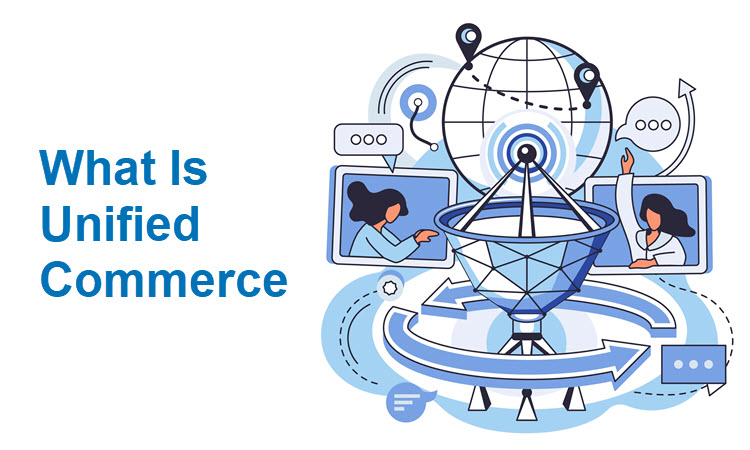Unified commerce strives to fill in the gaps of its predecessors: single-channel, multi-channel, and omni-channel.
While unified commerce is similar to omnichannel, omnichannel ecommerce involves using separate IT solutions for every customer point of contact. Besides being impractical, costly, and difficult to manage, this approach confuses customers and reduces revenue.
Find out what unified commerce is, how it improves the customer experience, and what it takes to implement it in your company.
What Is Unified Commerce?

Unified commerce is a strategy that connects all customer-facing channels and back-end operations in a centralized software solution, also known as a unified commerce platform. The purpose of this strategy is to simplify and unify sales, marketing, and customer support activities and provide a truly seamless shopping experience.
A unified commerce platform consists of four key components:
- Interactions. Unified commerce relies on data collection. Tracking customer interactions with every sales channel in a uniform way results in insights that make space for departmental improvements, whether it is customer service, product development, or any other.
- Channels. Unified commerce aims to provide a seamless and enjoyable customer experience regardless of whether customers interact with a brand using one or multiple channels.
- Systems. Unified commerce synchronizes and harmonizes all systems within a company.
- Products. Unified commerce synchronizes product information across all sales channels.
Unified Commerce vs. Other Strategies
Before we take a closer look at what unified commerce is, find out how it compares to other popular retail strategies.
| Definition | Benefits | Challenges | |
|---|---|---|---|
| Single channel | Customers use a single channel to engage with the brand. | Simple customer experience. Does not require much investment. | Companies with a single-channel strategy are missing other selling opportunities, like social commerce or m-Commerce. |
| Multi-channel | Customers use multiple channels to interact with a brand. Every channel has a learning curve and represents an individual silo. | Increases brand visibility due to multi-channel presence. | Companies must invest in separate platforms and maintain each channel separately. |
| Omni-channel | Customers use multiple channels to communicate with a brand but with more freedom and convenience. | Allows customers to decide what their customer journey will look like. They can put products in their cart via a mobile app, complete their purchase on the webstore and pick up their products in person. | Companies must invest in third-party integrations that allow continuous data flow between sales channels. |
| Unified commerce | Customers communicate with a brand seamlessly and with ease using multiple channels. Interactions are more flexible and personalized. | Connected back-end systems with customer-facing channels. Provides valuable insight into customer journeys. Facilitates departmental improvements by leveraging data-driven insights. | Companies must invest in a unified commerce system, as well as its implementation and maintenance. |
Note: Read our article for a more in-depth look at the differences between omni-channel and multi-channel strategies.
Unified Commerce Examples

Unified commerce centralizes all internal and external background processes. Since all data is stored in a centralized system, all departments have access to the data in real-time.
Below are examples of how that positively affects various departments in an ecommerce business:
Example 1
Unified commerce allows a salesperson in a brick-and-mortar retail store to use the same platform to:
- Process sales.
- See a customer’s purchase history.
- Check the store’s inventory for a particular product.
- Check the inventory of every retail location and warehouse for a particular product.
- Order the product on the customer’s behalf.
- Track and provide information about the delivery of an ordered product.
- Process returns.
Example 2
An inventory manager would benefit from a unified commerce strategy because they could use a single platform to:
- Learn about best- and worst-performing products.
- Redistribute products between retail locations according to their performance.
- Organize restocks for individual retail locations.
- Handle returned products and ship them for resale (when applicable).
Example 3
Marketing departments could use a unified commerce platform to get more insight into:
- Buyer personas.
- Local and regional sales trends.
- Emerging sales trends.
- Best and worst performing advertising channels and marketing campaigns.
Unified Commerce Advantages and Disadvantages
Before making a large-scale and costly decision, such as implementing a unified commerce strategy, it’s important to consider the benefits and challenges that come with it to prevent any future issues from arising.
Advantages
1. Eliminates the need for multiple third-party integrations
Unified commerce platforms replace disconnected IT services with a single software that handles:
- Sales.
- Logistics.
- Customer service.
- Resource planning.
- Order management.
- Payment processing.
- Inventory management.
- Customer relationship management (CRM).
- Product procurement/production management, and many more departmental processes.
Replacing several software vendors with one significantly decreases costs in the long run.
2. Simplifies staff redistribution
Dealing with a multitude of software solutions makes people operations difficult, lengthy, and costly. Training new hires can only be done by department supervisors, and redistributing staff to another division would require additional training.
Replacing several software solutions with a unified platform allows easier staff onboarding and redistribution as needed.
3. Improves overall customer experience

A centralized data system, which is the staple of unified commerce, allows brands to provide a fulfilling customer experience via:
- Real-time order tracking.
- Accurate real-time inventory information.
- Quick payment solutions across all sales channels via authorization and previously collected payment information.
- Tailored customer experiences, such as exclusive deals and product recommendations based on the customer’s previous interactions with the brand.
The strategy also gives customers the freedom to choose a customer journey that meets their needs. For example, a customer can order a product online, collect it at a retail location, and return it by mail in case of issues.
4. Provides complete customer profiles
Centralized data systems allow brands to learn more about customers and create an accurate buyer persona. Retail stores with a successful unified commerce strategy use data from their existing customer base to tailor marketing and sales strategies accordingly. As a result, business generates more recurring revenue and reduces the customer churn rate.
5. Provides access to real-time data
Access to real-time data minimizes operational errors and allows for quick action in emergencies.
If a chain of retail stores were to experience sales that exceeded expectations, a unified commerce strategy would allow quick and efficient organization of store restocks.
Disadvantages
1. Lengthy and costly implementation
Transitioning from multiple third-party services to a single platform requires time and funding directly proportional to the size of the company in question. Businesses that decide to switch to unified commerce must invest in:
- Reliable server infrastructure that can support the heavy data load.
- A flexible supply chain and delivery system.
- Staff training.
Startups handle major changes better than large corporations because of their small number of employees. However, startups might lack the financial means to implement them. On the other hand, corporations have sufficient funds to support the implementation of unified commerce, but the process will take significantly longer to complete.
2. Company reorganization
Implementing a unified commerce strategy results in customers having new needs and expectations that must be met. Departmental and company reorganizations help meet those needs but are followed by:
- Staff dissatisfaction.
- Poor productivity due to stress related to questionable job security.
- Costs of retraining and hiring more people or decrease in staff loyalty due to fired employees.
3. Risk of wrong vendor choice
Choosing a unified commerce platform vendor is the key to the success of this strategy. The vendor must understand your company’s goals, existing conditions, and the potential for improvement.
A wrong vendor choice could lead to unmet expectations in the form of poor system performance and technical support. In that case, repairing the damage would take vast amounts of time and money.
How to Get Started with Unified Commerce?

A successful unified commerce strategy requires an approach that is:
- Customer-oriented. The purpose of all company efforts is customer acquisition, satisfaction, and retention.
- Data-centric. Businesses look at data as their primary asset, while its use can and will vary. The flexibility of this approach gives companies the opportunity to organize their processes cheaper and more efficiently.
- Vendor-agnostic. Businesses don’t rely on a single IT service provider and are open to change should a better opportunity arise.
If such an approach aligns with your business’ values, it’s time to find out whether a unified commerce strategy would be a good fit for your company.
Getting started with unified commerce requires you to:
- Analyze the existing customer experience. Redesign customer journeys with a unified approach in mind. Do you notice any improvements?
- Perform competitor analysis. Do your competitors use a unified commerce strategy and how does it benefit them?
-
Assess technological capabilities. Can your current setup handle the switch to unified commerce or will upgrades be necessary?
-
Assess financial capabilities. Can your company’s budget handle implementation costs
-
Find a reliable vendor in your niche. Is there a vendor that worked with companies like yours? Why did those companies choose that particular vendor? Can that vendor meet your needs and expectations?
If you conclude that your business isn’t ready for such a change, an omni-channel strategy might be a better choice. Find out how CCBill integrates with your tech stack and helps your business expand to additional sales channels.
Conclusion
The success of a unified commerce strategy depends on the merchant’s needs. The definitions, tips, and examples mentioned in this guide will help you decide whether switching to unified commerce would benefit your business.
